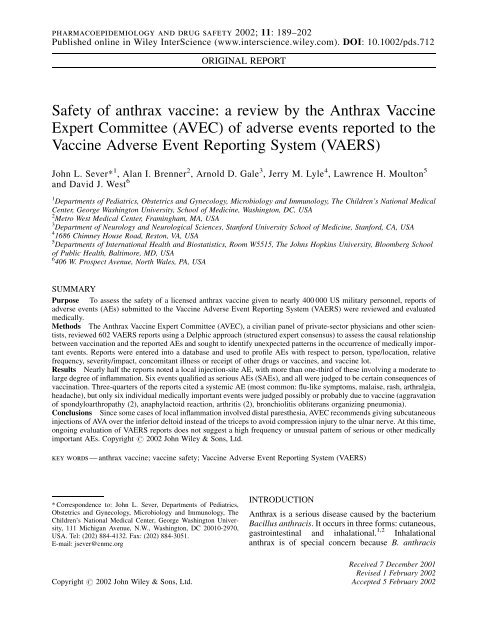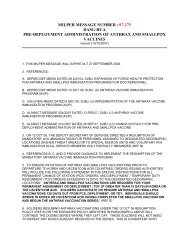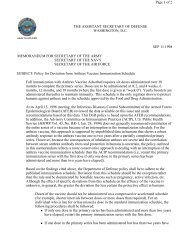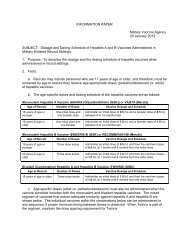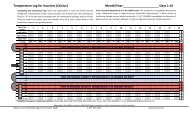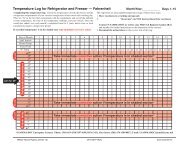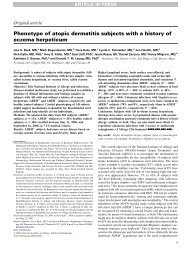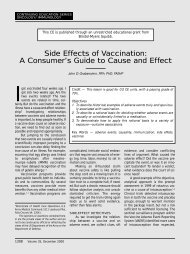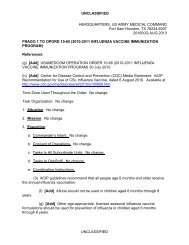Safety of anthrax vaccine: a review by the Anthrax Vaccine Expert ...
Safety of anthrax vaccine: a review by the Anthrax Vaccine Expert ...
Safety of anthrax vaccine: a review by the Anthrax Vaccine Expert ...
You also want an ePaper? Increase the reach of your titles
YUMPU automatically turns print PDFs into web optimized ePapers that Google loves.
pharmacoepidemiology and drug safety 2002; 11: 189–202<br />
Published online in Wiley InterScience (www.interscience.wiley.com). DOI: 10.1002/pds.712<br />
ORIGINAL REPORT<br />
<strong>Safety</strong> <strong>of</strong> <strong>anthrax</strong> <strong>vaccine</strong>: a <strong>review</strong> <strong>by</strong> <strong>the</strong> <strong>Anthrax</strong> <strong>Vaccine</strong><br />
<strong>Expert</strong> Committee (AVEC) <strong>of</strong> adverse events reported to <strong>the</strong><br />
<strong>Vaccine</strong> Adverse Event Reporting System (VAERS)<br />
John L. Sever* 1 ,AlanI.Brenner 2 ,ArnoldD.Gale 3 , Jerry M. Lyle 4 , Lawrence H. Moulton 5<br />
and David J. West 6<br />
1 Departments <strong>of</strong> Pediatrics, Obstetrics and Gynecology, Microbiology and Immunology, The Children’s National Medical<br />
Center, George Washington University, School <strong>of</strong> Medicine, Washington, DC, USA<br />
2 Metro West Medical Center, Framingham, MA, USA<br />
3 Department <strong>of</strong> Neurology and Neurological Sciences, Stanford University School <strong>of</strong> Medicine, Stanford, CA, USA<br />
4 1686 Chimney House Road, Reston, VA, USA<br />
5 Departments <strong>of</strong> International Health and Biostatistics, Room W5515, The Johns Hopkins University, Bloomberg School<br />
<strong>of</strong> Public Health, Baltimore, MD, USA<br />
6 406 W. Prospect Avenue, North Wales, PA, USA<br />
SUMMARY<br />
Purpose To assess <strong>the</strong> safety <strong>of</strong> a licensed <strong>anthrax</strong> <strong>vaccine</strong> given to nearly 400 000 US military personnel, reports <strong>of</strong><br />
adverse events (AEs) submitted to <strong>the</strong> <strong>Vaccine</strong> Adverse Event Reporting System (VAERS) were <strong>review</strong>ed and evaluated<br />
medically.<br />
Methods The <strong>Anthrax</strong> <strong>Vaccine</strong> <strong>Expert</strong> Committee (AVEC), a civilian panel <strong>of</strong> private-sector physicians and o<strong>the</strong>r scientists,<br />
<strong>review</strong>ed 602 VAERS reports using a Delphic approach (structured expert consensus) to assess <strong>the</strong> causal relationship<br />
between vaccination and <strong>the</strong> reported AEs and sought to identify unexpected patterns in <strong>the</strong> occurrence <strong>of</strong> medically important<br />
events. Reports were entered into a database and used to pr<strong>of</strong>ile AEs with respect to person, type/location, relative<br />
frequency, severity/impact, concomitant illness or receipt <strong>of</strong> o<strong>the</strong>r drugs or <strong>vaccine</strong>s, and <strong>vaccine</strong> lot.<br />
Results Nearly half <strong>the</strong> reports noted a local injection-site AE, with more than one-third <strong>of</strong> <strong>the</strong>se involving a moderate to<br />
large degree <strong>of</strong> inflammation. Six events qualified as serious AEs (SAEs), and all were judged to be certain consequences <strong>of</strong><br />
vaccination. Three-quarters <strong>of</strong> <strong>the</strong> reports cited a systemic AE (most common: flu-like symptoms, malaise, rash, arthralgia,<br />
headache), but only six individual medically important events were judged possibly or probably due to <strong>vaccine</strong> (aggravation<br />
<strong>of</strong> spondyloarthropathy (2), anaphylactoid reaction, arthritis (2), bronchiolitis obliterans organizing pneumonia).<br />
Conclusions Since some cases <strong>of</strong> local inflammation involved distal pares<strong>the</strong>sia, AVEC recommends giving subcutaneous<br />
injections <strong>of</strong> AVA over <strong>the</strong> inferior deltoid instead <strong>of</strong> <strong>the</strong> triceps to avoid compression injury to <strong>the</strong> ulnar nerve. At this time,<br />
ongoing evaluation <strong>of</strong> VAERS reports does not suggest a high frequency or unusual pattern <strong>of</strong> serious or o<strong>the</strong>r medically<br />
important AEs. Copyright # 2002 John Wiley & Sons, Ltd.<br />
key words — <strong>anthrax</strong> <strong>vaccine</strong>; <strong>vaccine</strong> safety; <strong>Vaccine</strong> Adverse Event Reporting System (VAERS)<br />
* Correspondence to: John L. Sever, Departments <strong>of</strong> Pediatrics,<br />
Obstetrics and Gynecology, Microbiology and Immunology, The<br />
Children’s National Medical Center, George Washington University,<br />
111 Michigan Avenue, N.W., Washington, DC 20010-2970,<br />
USA. Tel: (202) 884-4132. Fax: (202) 884-3051.<br />
E-mail: jsever@cnmc.org<br />
INTRODUCTION<br />
<strong>Anthrax</strong> is a serious disease caused <strong>by</strong> <strong>the</strong> bacterium<br />
Bacillus anthracis. It occurs in three forms: cutaneous,<br />
gastrointestinal and inhalational. 1,2 Inhalational<br />
<strong>anthrax</strong> is <strong>of</strong> special concern because B. anthracis<br />
Received 7 December 2001<br />
Revised 1 February 2002<br />
Copyright # 2002 John Wiley & Sons, Ltd. Accepted 5 February 2002
190 j. l. sever et al.<br />
spores can easily be weaponized and dispersed in an<br />
aerosol. 3 Inhaled spores initiate an infection whose<br />
early symptoms resemble those <strong>of</strong> many benign<br />
respiratory infections. However, inhalational <strong>anthrax</strong><br />
progresses rapidly, causing abrupt respiratory distress<br />
with hemorrhagic necrosis <strong>of</strong> pulmonary and thoracic<br />
tissues resulting in massive septicemia and toxemia.<br />
Mortality rates are high even with intensive antibiotic<br />
<strong>the</strong>rapy and are nearly 100% without <strong>the</strong>rapy. At least<br />
17 nations are believed to have <strong>of</strong>fensive biological<br />
weapons programs that could include B. anthracis, 4<br />
and Iraq has specifically acknowledged weaponizing<br />
<strong>anthrax</strong>. 5 Recent illnesses and deaths in <strong>the</strong> US<br />
associated with exposure to spores <strong>of</strong> B. anthracis in<br />
mail fur<strong>the</strong>r underscore <strong>the</strong> grave potential this bacterium<br />
has as an instrument <strong>of</strong> bioterrorism.<br />
The Department <strong>of</strong> Defense (DoD) is vaccinating<br />
US Armed Forces personnel with a <strong>anthrax</strong> <strong>vaccine</strong><br />
licensed in 1970 that previously had limited use. 6 As<br />
<strong>of</strong> December 1999, <strong>the</strong> <strong>Anthrax</strong> <strong>Vaccine</strong> Immunization<br />
Program (AVIP) had administered more than 1.3 million<br />
doses <strong>of</strong> <strong>vaccine</strong> to nearly 400 000 military personnel<br />
and civilian employees <strong>of</strong> DoD. 6 When AVIP<br />
is fully implemented, more than 2.2 million personnel<br />
(all <strong>of</strong> <strong>the</strong> 1.37 million Active duty forces and 890 000<br />
selected members <strong>of</strong> <strong>the</strong> 1.35 million Reserve forces)<br />
will be scheduled to receive <strong>vaccine</strong> each year. 7<br />
<strong>Anthrax</strong> <strong>vaccine</strong> is made from a sterile filtrate <strong>of</strong><br />
a microaerophilic culture <strong>of</strong> an attenuated, nonencapsulated,<br />
non-proteolytic strain <strong>of</strong> B. anthracis. 8,9<br />
Protective antigen (PA) is <strong>the</strong> predominant protein<br />
immunogen in <strong>the</strong> <strong>vaccine</strong>, although vaccinated animals<br />
have also been shown to develop antibodies<br />
against o<strong>the</strong>r toxin proteins present in small amounts<br />
(e.g. lethal factor (LF) and edema factor (EF)). 10,11<br />
The culture filtrate is adsorbed to aluminum hydroxide<br />
to create <strong>the</strong> final <strong>vaccine</strong>. Accordingly, this <strong>vaccine</strong>,<br />
<strong>Anthrax</strong> <strong>Vaccine</strong> Adsorbed, is denoted throughout<br />
<strong>the</strong> remainder <strong>of</strong> <strong>the</strong> paper as AVA. AVA is administered<br />
as a primary series <strong>of</strong> six subcutaneous injections<br />
at 0, 2 and 4 weeks and 6, 12 and 18 months, followed<br />
<strong>by</strong> annual booster injections. 6<br />
The mandate to vaccinate such a large population<br />
under AVIP has stimulated questions regarding <strong>the</strong><br />
safety <strong>of</strong> AVA. For example, witnesses at a 1999 Congressional<br />
hearing expressed concern that recipients<br />
<strong>of</strong> AVA might be at increased risk <strong>of</strong> incurring medically<br />
important adverse events (AEs), including a<br />
chronic illness characterized <strong>by</strong> fatigue, sleep disturbance,<br />
neurologic complaints, cognitive dysfunction<br />
and o<strong>the</strong>r symptoms. 12 Citing data from human clinical<br />
studies and post-licensure use, FDA <strong>of</strong>ficials have<br />
concluded that AVA appears to be safe. 9,13,14<br />
Several kinds <strong>of</strong> studies are needed for comprehensive<br />
assessment <strong>of</strong> AVA safety and tolerability. Those<br />
involving self-reporting or direct monitoring <strong>of</strong><br />
injection-site and systemic AEs following injection<br />
<strong>of</strong> AVA in several hundred or thousand <strong>vaccine</strong>es<br />
are useful for estimating <strong>the</strong> incidence and consequences<br />
<strong>of</strong> relatively common AEs. 9,15–18 However,<br />
additional surveillance or structured observational<br />
studies <strong>of</strong> very large numbers <strong>of</strong> <strong>vaccine</strong>es will be<br />
needed to detect rare AEs or to estimate precisely<br />
<strong>the</strong> incidence <strong>of</strong> less common AEs. One means <strong>of</strong><br />
detecting uncommon AEs and gaining at least a qualitative<br />
sense as to whe<strong>the</strong>r some may be occurring at<br />
an unexpected frequency is through ongoing <strong>review</strong> <strong>of</strong><br />
reports submitted to <strong>the</strong> <strong>Vaccine</strong> Adverse Event<br />
Reporting System (VAERS), a passive surveillance<br />
program founded in 1990 that is cooperatively implemented<br />
<strong>by</strong> <strong>the</strong> Food and Drug Administration (FDA)<br />
and <strong>the</strong> Centers for Disease Control and Prevention<br />
(CDC). 19,20,21 While subject to limitations inherent<br />
to all systems <strong>of</strong> passive surveillance (i.e. underreporting<br />
as well as incomplete, inaccurate, and<br />
biased reporting <strong>of</strong> events), a <strong>review</strong> <strong>of</strong> VAERS<br />
reports can at least (1) identify those AEs that healthcare<br />
providers or <strong>vaccine</strong>es feel are important enough<br />
to report, (2) generate a signal that some medically<br />
important event may be occurring at a higher than<br />
expected frequency, or (3) reveal trends in reporting<br />
(person, place, time) that may signify a safety problem<br />
(e.g. <strong>the</strong> association <strong>of</strong> an AE with one or a few lots <strong>of</strong><br />
<strong>vaccine</strong>). That information <strong>the</strong>n can be used to direct<br />
<strong>the</strong> development <strong>of</strong> large prospective or retrospective<br />
(case–control) studies capable <strong>of</strong> generating more precise<br />
and less biased estimates <strong>of</strong> <strong>the</strong> risk <strong>of</strong> an uncommon<br />
AE and its possible causal relationship to AVA.<br />
The DoD issued a policy directive in April 1998<br />
requiring Service healthcare providers to report to<br />
VAERS any event following receipt <strong>of</strong> AVA that<br />
resulted in hospitalization or loss <strong>of</strong> duty (LOD), as<br />
well as events suspected to have resulted from contamination<br />
<strong>of</strong> a <strong>vaccine</strong> lot. 22 It also encourages providers<br />
to report o<strong>the</strong>r AEs that appear to be<br />
unexpected ei<strong>the</strong>r in nature or severity, and states that<br />
ei<strong>the</strong>r <strong>the</strong> patient or a healthcare provider may directly<br />
submit a report to VAERS for any possible AE. To<br />
help ensure an objective evaluation <strong>of</strong> <strong>the</strong>se reports,<br />
in June 1998 <strong>the</strong> Surgeon General <strong>of</strong> <strong>the</strong> United States<br />
Army requested that an independent civilian panel be<br />
created to perform ongoing medical assessment <strong>of</strong><br />
VAERS reports concerning AVA.<br />
The Department <strong>of</strong> Health and Human Services<br />
(DHHS) agreed to organize such a panel and, following<br />
a model established <strong>by</strong> <strong>the</strong> Canadian Advisory<br />
Copyright # 2002 John Wiley & Sons, Ltd. Pharmacoepidemiology and Drug <strong>Safety</strong>, 2002; 11: 189–202
Committee on Causality Assessment, 23 formed <strong>the</strong><br />
<strong>Anthrax</strong> <strong>Vaccine</strong> <strong>Expert</strong> Committee (AVEC). Support<br />
for <strong>the</strong> first year <strong>of</strong> AVEC activity was provided to <strong>the</strong><br />
Health Resources and Services Administration<br />
(HRSA) <strong>of</strong> <strong>the</strong> DHHS through an interagency agreement<br />
with <strong>the</strong> National <strong>Vaccine</strong> Program Office<br />
(NVPO), with funding for subsequent years provided<br />
through an interagency agreement with <strong>the</strong> DoD that<br />
specifies <strong>the</strong> HRSA has full independence with<br />
respect to <strong>the</strong> actions and decisions <strong>of</strong> AVEC.<br />
The membership <strong>of</strong> AVEC consists <strong>of</strong> privatesector<br />
physicians and o<strong>the</strong>r scientists recruited<br />
through <strong>the</strong> <strong>Expert</strong> Witness Program <strong>of</strong> <strong>the</strong> <strong>Vaccine</strong><br />
Injury Compensation Program <strong>of</strong> HRSA, who have<br />
expertise in <strong>the</strong> fields <strong>of</strong> statistics, epidemiology,<br />
infectious diseases, neurology, rheumatology, and<br />
vaccinology. AVEC has liaison members and support<br />
staff from <strong>the</strong> DHHS and <strong>the</strong> DoD, including representatives<br />
from <strong>the</strong> FDA/Center for Biologics Evaluation<br />
and Research, <strong>the</strong> CDC/National Immunization<br />
Program, <strong>the</strong> HRSA/National <strong>Vaccine</strong> Injury Compensation<br />
Program, and <strong>the</strong> Army Surgeon General’s<br />
Office. The non-medical members <strong>of</strong> AVEC, liaison<br />
governmental members, and o<strong>the</strong>r support personnel<br />
play no role in assessing <strong>the</strong> causal relationship<br />
between AVA and an AE; that is <strong>the</strong> sole province<br />
<strong>of</strong> <strong>the</strong> medically-qualified civilian experts.<br />
AVEC is charged with conducting an ongoing<br />
<strong>review</strong> <strong>of</strong> VAERS reports that describe AEs occurring<br />
after receipt <strong>of</strong> AVA. One objective <strong>of</strong> this <strong>review</strong> is to<br />
descriptively pr<strong>of</strong>ile <strong>the</strong> reported AEs with regard to<br />
person (age, gender, Service), type/location (specific<br />
event/body system; local injection site reactions versus<br />
systemic events) relative frequency, severity/impact<br />
(need for medical assistance, loss <strong>of</strong> duty, classification<br />
<strong>of</strong> an event as serious), concomitant illness or receipt<br />
<strong>of</strong> o<strong>the</strong>r drugs or <strong>vaccine</strong>s, and <strong>vaccine</strong> lot, and to look<br />
for associations that might warrant closer study and<br />
evaluation. A second objective is to medically evaluate<br />
each reported AE and, subject to limitations<br />
imposed <strong>by</strong> <strong>the</strong> incomplete information provided in<br />
many VAERS reports, to assess <strong>the</strong> causal relationship<br />
between an AE and prior receipt <strong>of</strong> AVA. While many<br />
<strong>of</strong> <strong>the</strong>se judgements must be considered tentative, <strong>the</strong><br />
process <strong>of</strong> assigning causality ratings is integral to one<br />
<strong>of</strong> AVEC’s most important functions, i.e. to continually<br />
assess whe<strong>the</strong>r some serious or o<strong>the</strong>r medically<br />
important AE that may be causally related to receipt<br />
<strong>of</strong> <strong>vaccine</strong> seems to be occurring at an elevated<br />
frequency and ought to be made <strong>the</strong> subject <strong>of</strong> a cautionary<br />
use statement and/or a controlled study to estimate<br />
more precisely <strong>the</strong> risks associated with<br />
vaccination.<br />
safety <strong>of</strong> <strong>anthrax</strong> <strong>vaccine</strong> 191<br />
This paper is <strong>the</strong> first in a planned series <strong>of</strong> reports<br />
from AVEC; it summarizes findings from 602 VAERS<br />
reports concerning AVA that were filed in 1998 and<br />
1999 and <strong>review</strong>ed over a 1-year period between 7<br />
January 1999 and 6 January 2000.<br />
METHODS<br />
VAERS reports<br />
Each VAERS report has a unique case number. The<br />
report form has space in which to record <strong>the</strong> name,<br />
address, and telephone number <strong>of</strong> <strong>the</strong> <strong>vaccine</strong> recipient,<br />
<strong>the</strong> person administering <strong>the</strong> <strong>vaccine</strong> and <strong>the</strong> person<br />
reporting <strong>the</strong> AE, <strong>the</strong> <strong>vaccine</strong>e’s age and sex, <strong>the</strong><br />
type, dose number and lot number <strong>of</strong> each <strong>vaccine</strong><br />
given, date <strong>of</strong> vaccination, date <strong>of</strong> onset and description<br />
<strong>of</strong> <strong>the</strong> AE (including clinical and laboratory data),<br />
information concerning pre-existing illnesses and/or<br />
medications, significant consequences <strong>of</strong> <strong>the</strong> AE,<br />
and <strong>the</strong> outcome at <strong>the</strong> time <strong>of</strong> <strong>the</strong> report. The VAERS<br />
report form does not solicit information concerning<br />
race or socioeconomic variables, such as income, pr<strong>of</strong>ession,<br />
or educational level. While virtually all <strong>of</strong> <strong>the</strong><br />
reports concerning AVA stem from military personnel,<br />
<strong>the</strong> form does not specifically solicit information concerning<br />
branch <strong>of</strong> service, rank, or active/reserve status.<br />
That information can be surmised in some cases<br />
from <strong>the</strong> reporting location and/or o<strong>the</strong>r free form text<br />
presented <strong>by</strong> <strong>the</strong> reporter.<br />
Any person (i.e. <strong>the</strong> <strong>vaccine</strong>e, a healthcare provider,<br />
or o<strong>the</strong>r individual) may initiate a report to VAERS.<br />
Thus, some <strong>of</strong> <strong>the</strong> VAERS reports concerning AEs<br />
following receipt <strong>of</strong> AVA are sent to <strong>the</strong> FDA directly<br />
from DoD medical channels. These undergo a DoD<br />
quality-assurance process to fill in missing demographic<br />
information from personnel and immunization<br />
databases. O<strong>the</strong>r reports come directly from<br />
<strong>vaccine</strong> recipients or civilian healthcare providers<br />
and may provide somewhat less complete information<br />
than those channeled through <strong>the</strong> DoD. Once received<br />
<strong>by</strong> <strong>the</strong> FDA, <strong>the</strong> reports are <strong>the</strong>n processed <strong>by</strong> a private<br />
contractor that maintains <strong>the</strong> system for <strong>the</strong> agency.<br />
Through an agreement with <strong>the</strong> FDA, that contractor<br />
continually forwards to AVEC just those reports concerning<br />
AEs experienced <strong>by</strong> individuals given AVA.<br />
To ensure confidentiality, <strong>the</strong> contractor first redacts<br />
individual patient identifiers (name, address (street/<br />
city), telephone number and birth date (except for year<br />
<strong>of</strong> birth)) from each report before it is sent to AVEC. If<br />
an original report lacks information needed to assess<br />
<strong>the</strong> causal relationship between an AE and prior<br />
receipt <strong>of</strong> AVA, AVEC may ask <strong>the</strong> VAERS contractor<br />
Copyright # 2002 John Wiley & Sons, Ltd. Pharmacoepidemiology and Drug <strong>Safety</strong>, 2002; 11: 189–202
192 j. l. sever et al.<br />
to request additional information from <strong>the</strong> original<br />
reporter. However, <strong>the</strong>re is no way to ensure a<br />
response, and more <strong>of</strong>ten than not, <strong>the</strong> desired information<br />
cannot be obtained. VAERS reports <strong>review</strong>ed<br />
<strong>by</strong> AVEC are <strong>the</strong>n forwarded to <strong>the</strong> DoD, where a contractor<br />
codes and keys <strong>the</strong> data into an ACCESS database<br />
maintained for use <strong>by</strong> AVEC (see subsection<br />
entitled ‘AVEC database’).<br />
Serious AEs (SAEs) and o<strong>the</strong>r medically<br />
important AEs (OMIAEs)<br />
One section <strong>of</strong> <strong>the</strong> VAERS report form (item 8) solicits<br />
information regarding several events (death, lifethreatening<br />
illness, hospitalization, prolongation <strong>of</strong> an<br />
existing hospitalization and permanent disability) that<br />
are among those <strong>the</strong> FDA uses to define a ‘serious’ AE<br />
(SAE). In evaluating VAERS reports, AVEC decided<br />
to create a supplementary category called ‘o<strong>the</strong>r medically<br />
important AE’ (OMIAE). An AE was classified<br />
as an OMIAE if <strong>the</strong> affected individual was judged to<br />
have significant risk <strong>of</strong> chronic disability (i.e. >6<br />
months even though 6 months have not yet elapsed)<br />
or major illness, even though one <strong>of</strong> <strong>the</strong> previous<br />
defining criteria <strong>of</strong> an SAE was not checked on <strong>the</strong><br />
VAERS form. Any AE meeting <strong>the</strong> definitional criteria<br />
<strong>of</strong> an SAE or OMIAE is also considered to be<br />
a ‘medically important’ event.<br />
Flu-like symptoms and ‘multi-symptom syndrome’<br />
Two composite symptom sets were created to facilitate<br />
a survey <strong>of</strong> VAERS reports for evidence <strong>of</strong> constellations<br />
<strong>of</strong> certain kinds <strong>of</strong> symptoms. The<br />
medically-qualified members <strong>of</strong> AVEC utilized a<br />
Delphic approach to achieve an expert consensus with<br />
respect to <strong>the</strong> definition <strong>of</strong> flu-like symptoms. 24 The<br />
term flu-like symptoms was applied to a report involving<br />
three or more <strong>of</strong> <strong>the</strong> following systemic events:<br />
fever (>100.4 F, if specified), chills, headache, photophobia,<br />
aching eyes, anorexia, nausea, myalgia,<br />
arthralgia, malaise and fatigue but with at most one<br />
symptoms referable to ei<strong>the</strong>r <strong>the</strong> respiratory or gastrointestinal<br />
tract. The aggregate term ‘multi-symptom<br />
syndrome’ was coined to facilitate a <strong>review</strong> <strong>of</strong> VAERS<br />
reports in response to public concern that AVA might<br />
be associated with a chronic illness characterized <strong>by</strong><br />
fatigue, sleep disturbance, neurologic complaints,<br />
cognitive dysfunction, and o<strong>the</strong>r symptoms. 12 AVEC<br />
operationally defined ‘multi-symptom syndrome’ as<br />
<strong>the</strong> co-occurrence <strong>of</strong> at least three <strong>of</strong> <strong>the</strong> following<br />
events: malaise/fatigue, pares<strong>the</strong>sia, memory loss,<br />
sleep disorder, and altered mentation. Given <strong>the</strong><br />
incomplete nature <strong>of</strong> reports made to VAERS, <strong>the</strong><br />
duration <strong>of</strong> <strong>the</strong> symptoms could not always be evaluated,<br />
so chronicity per se was not part <strong>of</strong> <strong>the</strong> definition<br />
<strong>of</strong> this symptom complex.<br />
Medical <strong>review</strong> <strong>of</strong> VAERS reports<br />
VAERS reports were studied and abstracted <strong>by</strong> a civilian<br />
AVEC medical <strong>review</strong>er, who developed a preliminary<br />
opinion concerning <strong>the</strong> causal relationship<br />
between AVA and <strong>the</strong> reported AE(s) in each report<br />
taking into consideration (1) cumulative information<br />
on <strong>the</strong> consistency <strong>of</strong> association in different groups,<br />
sexes, or ages with inactivated <strong>vaccine</strong>s generally and<br />
AVA specifically, (2) <strong>the</strong> specificity to AVA alone (e.g.<br />
did <strong>the</strong> subject have a concurrent or predisposing illness<br />
or did he/she receive o<strong>the</strong>r <strong>vaccine</strong>s or medications<br />
at <strong>the</strong> same time as AVA?), (3) <strong>the</strong> temporal<br />
relationship <strong>of</strong> <strong>the</strong> AE to receipt <strong>of</strong> AVA, and (4) biological<br />
plausibility (i.e. is <strong>the</strong>re a clear physiological<br />
basis for thinking that an AE could have been caused<br />
<strong>by</strong> AVA or have successive doses <strong>of</strong> <strong>vaccine</strong> repeatedly<br />
induced a particular AE?).<br />
The medical <strong>review</strong>er’s initial assessment, along<br />
with <strong>the</strong> original VAERS report and o<strong>the</strong>r submitted<br />
medical records, was subsequently <strong>review</strong>ed <strong>by</strong> a<br />
panel <strong>of</strong> <strong>the</strong> medically-qualified civilian members <strong>of</strong><br />
AVEC. A Delphic approach was again used to achieve<br />
expert consensus concerning <strong>the</strong> causal relationship<br />
between each reported AE and AVA. 24 If an original<br />
report lacked critical information, AVEC deferred<br />
making a final assessment and sought additional medical<br />
records through <strong>the</strong> independent contractor that<br />
maintains <strong>the</strong> VAERS database for <strong>the</strong> CDC/FDA.<br />
When available, such records were evaluated for additional<br />
clinical, laboratory, radiographic and pathological<br />
information. In most instances, <strong>the</strong> initial<br />
diagnoses were confirmed <strong>by</strong> this extended <strong>review</strong>;<br />
rarely, new information led to revision <strong>of</strong> <strong>the</strong> original<br />
diagnosis. When additional medical records were not<br />
available, AVEC accepted <strong>the</strong> diagnosis provided in<br />
<strong>the</strong> initial VAERS report.<br />
A World Health Organization (WHO) scale consisting<br />
<strong>of</strong> <strong>the</strong> categories: (1) very likely/certain, (2) probable,<br />
(3) possible, (4) unlikely, (5) unrelated and (6)<br />
unclassifiable was used to classify <strong>the</strong> causal relationship<br />
between an AE and AVA. 23<br />
AVEC database<br />
Data from <strong>the</strong> VAERS reports were coded and keyed<br />
into an ACCESS database maintained <strong>by</strong> <strong>the</strong> Eagle<br />
Group under contract to <strong>the</strong> DoD. This was audited<br />
Copyright # 2002 John Wiley & Sons, Ltd. Pharmacoepidemiology and Drug <strong>Safety</strong>, 2002; 11: 189–202
y <strong>the</strong> AVEC medical <strong>review</strong>er, who compared critical<br />
field database entries with source documents for<br />
100% <strong>of</strong> <strong>the</strong> reports involving a SAE or OMIAE plus<br />
a 10% sample <strong>of</strong> <strong>the</strong> remaining reports randomly<br />
selected <strong>by</strong> civilian AVEC members. All erroneous<br />
database entries detected in this audit were corrected.<br />
When abstracting VAERS reports, <strong>the</strong> AVEC<br />
<strong>review</strong>er applied codes for aggregate classes <strong>of</strong> local<br />
and systemic reactions defined in a DoD document<br />
entitled ‘Clinical Practice Guidelines for Managing<br />
Adverse Events after Vaccination’, 25 but did not code<br />
every individual sign or symptom. To facilitate <strong>the</strong><br />
summarization <strong>of</strong> reported events in a useful and manageable<br />
way but with more specificity than allowed <strong>by</strong><br />
<strong>the</strong>se aggregate classes <strong>of</strong> local and systemic reactions,<br />
AVEC created a simplified symptom set with<br />
96 categories. y First, <strong>the</strong> ACCESS database was<br />
merged with a data extract provided <strong>by</strong> <strong>the</strong> FDA containing<br />
COSTART (Coding Symbols for Thesaurus <strong>of</strong><br />
Adverse Reaction Terms) codes for all reported signs<br />
and symptoms in <strong>the</strong> set <strong>of</strong> VAERS reports concerning<br />
AVA. 26 Then, <strong>the</strong> hundreds <strong>of</strong> individual COSTART<br />
terms were assigned to 96 simplified symptom groupings<br />
that reflected a mixture <strong>of</strong> anatomic (e.g. nasal),<br />
physiologic (e.g. bronchospasm), and diagnostic (e.g.<br />
Guillain-Barré syndrome, thyroid disease) constructs.<br />
Synonymous medical symptoms such as itching and<br />
pruritus were combined in a single category, whereas<br />
important medical events <strong>of</strong> particular interest to <strong>the</strong><br />
committee (e.g. multiple sclerosis, arthritis) were each<br />
assigned to distinct categories. Following <strong>review</strong> and<br />
approval <strong>by</strong> <strong>the</strong> full committee, this simplified symptom<br />
set was used to create <strong>the</strong> summary listings <strong>of</strong><br />
AEs presented in this paper.<br />
DMSS database<br />
Denominator data were obtained from <strong>the</strong> Defense<br />
Medical Surveillance System (DMSS), which contains<br />
one record for every dose <strong>of</strong> AVA given during<br />
<strong>the</strong> reference period. A coded individual identification<br />
field enables linking multiple vaccinations to <strong>the</strong> same<br />
person. Duplicate records were eliminated <strong>by</strong> reference<br />
to date <strong>of</strong> vaccination, and typographical variants<br />
or errors regarding <strong>the</strong> lot <strong>of</strong> <strong>vaccine</strong> received were<br />
corrected to a uniform two-digit data field. To ensure<br />
confidentiality, no linkage was made between individual<br />
data in this database and <strong>the</strong> VAERS reports<br />
<strong>review</strong>ed <strong>by</strong> AVEC.<br />
y A listing <strong>of</strong> <strong>the</strong>se symptom categories will be provided on request<br />
<strong>by</strong> <strong>the</strong> senior author.<br />
safety <strong>of</strong> <strong>anthrax</strong> <strong>vaccine</strong> 193<br />
Data summaries and statistical analyses<br />
Reports made to VAERS represent an unknown fraction<br />
<strong>of</strong> all events that actually occur, and <strong>the</strong> frequency<br />
<strong>of</strong> reporting can be influenced <strong>by</strong> a variety <strong>of</strong><br />
unknown external factors. Thus, formal hypo<strong>the</strong>sis<br />
testing and o<strong>the</strong>r statistical assessments (e.g. p-values,<br />
confidence intervals) were generally not applied to <strong>the</strong><br />
univariate and bivariate data summaries in this paper.<br />
Instead, <strong>the</strong> paper provides descriptive summaries <strong>of</strong><br />
<strong>the</strong> reported AEs with regard to such variables as<br />
person, type/location, relative frequency, severity/<br />
impact, concomitant illness or receipt <strong>of</strong> o<strong>the</strong>r drugs<br />
or <strong>vaccine</strong>s, and <strong>vaccine</strong> lot.<br />
Most summaries <strong>of</strong> numerator data are based on <strong>the</strong><br />
number <strong>of</strong> reports. This slightly exceeds <strong>the</strong> number<br />
<strong>of</strong> <strong>vaccine</strong>es reporting one or more AEs because a<br />
few individuals filed reports following each <strong>of</strong> two<br />
or more different doses <strong>of</strong> <strong>vaccine</strong>. Summarizing at<br />
<strong>the</strong> report level captures information regarding <strong>the</strong><br />
variety and circumstances <strong>of</strong> <strong>the</strong> AEs that might be<br />
lost in a summary focused on persons. The paper also<br />
includes AE summaries at <strong>the</strong> medical event level,<br />
since some reports cited multiple signs or symptoms.<br />
To explore lot-to-lot variations in <strong>the</strong> reporting frequency<br />
for any AE or one involving hospitalization<br />
and/or LOD, data were analyzed via conditional logistic<br />
regression models. Two models were fit using <strong>the</strong><br />
numerator data from <strong>the</strong> VAERS reports plus denominator<br />
data from <strong>the</strong> DMSS database. In <strong>the</strong> first, <strong>the</strong><br />
approximate odds <strong>of</strong> an immunization leading to a<br />
VAERS report were modeled. In <strong>the</strong> second, <strong>the</strong> event<br />
<strong>of</strong> interest was a VAERS report that also had an associated<br />
hospitalization and/or LOD, i.e. a more severe<br />
(and perhaps more objective) version <strong>of</strong> <strong>the</strong> event in<br />
<strong>the</strong> first model. In both models, <strong>the</strong> data were restricted<br />
to <strong>the</strong> 12 lots that had been used for more than 50 000<br />
immunizations each. These lots were represented <strong>by</strong> 11<br />
dummy variables, with odds ratios comparing lots calculated<br />
<strong>by</strong> exponentiating differences between <strong>the</strong>ir<br />
coefficients. Also included were dummy variables to<br />
account for gender and calendar time <strong>of</strong> immunization.<br />
Odds ratios >2 were considered to be <strong>of</strong> potential clinical<br />
interest. Geographic variation in frequencies was<br />
accounted for <strong>by</strong> stratifying <strong>the</strong>se conditional logistic<br />
models on <strong>the</strong> locations (states or countries) from<br />
which <strong>the</strong> reports came, an approach that has been used<br />
successfully in o<strong>the</strong>r research on <strong>vaccine</strong> safety. 27<br />
Special assessment <strong>of</strong> selected AEs<br />
Beyond its routine <strong>review</strong> <strong>of</strong> all VAERS reports,<br />
AVEC occasionally assigns to one <strong>of</strong> its members<br />
Copyright # 2002 John Wiley & Sons, Ltd. Pharmacoepidemiology and Drug <strong>Safety</strong>, 2002; 11: 189–202
194 j. l. sever et al.<br />
having appropriate expertise <strong>the</strong> responsibility <strong>of</strong><br />
fur<strong>the</strong>r evaluating an AE <strong>of</strong> special interest. This<br />
might be done if <strong>the</strong> reporting frequency <strong>of</strong> a certain<br />
AE seems unexpectedly high or has an unusual distribution<br />
with respect to person, place or time, if <strong>the</strong>re is<br />
emerging evidence for a causal relationship between a<br />
particular AE and o<strong>the</strong>r <strong>vaccine</strong>s, or if <strong>the</strong>re has been<br />
considerable public interest expressed in <strong>the</strong> possibility<br />
<strong>of</strong> such a relationship. In <strong>the</strong> set <strong>of</strong> VAERS reports<br />
summarized in this paper, cases <strong>of</strong> pares<strong>the</strong>sia following<br />
vaccination elicited special interest and so were assigned<br />
to <strong>the</strong> neurologist-member <strong>of</strong> AVEC (A. D. G.) for more<br />
detailed <strong>review</strong> and evaluation.<br />
RESULTS<br />
Distribution <strong>of</strong> reported AEs <strong>by</strong> person, dose number,<br />
type, concomitant illness or treatment, severity and<br />
conceivable causality<br />
Table 1 shows that <strong>the</strong> subjects <strong>of</strong> VAERS reports<br />
tended to be older and were more <strong>of</strong>ten female than<br />
all <strong>vaccine</strong>es given AVA. Although many reports<br />
lacked information regarding Service affiliation, from<br />
those which did, it appears that <strong>vaccine</strong>es in <strong>the</strong> Air<br />
Force (including those in <strong>the</strong> Air Force reserve, data<br />
not shown) were more likely than those in o<strong>the</strong>r Services<br />
to report an AE. At <strong>the</strong> time <strong>of</strong> this study, 79% <strong>of</strong><br />
AVA injections given through AVIP represented first,<br />
second, or third doses <strong>of</strong> <strong>the</strong> primary vaccination series<br />
(Table 1). A similar proportion <strong>of</strong> <strong>the</strong> reports submitted<br />
to VAERS (82.5%) concerned AEs following<br />
one <strong>of</strong> <strong>the</strong> first three doses <strong>of</strong> AVA. An observational<br />
comparison <strong>of</strong> <strong>the</strong> number <strong>of</strong> reports submitted versus<br />
total doses given suggests that <strong>the</strong> likelyhood <strong>of</strong> a<br />
report was a greatest following <strong>the</strong> first dose and<br />
tended to decrease with subsequent doses.<br />
Table 2 fur<strong>the</strong>r classifies <strong>the</strong> 602 VAERS reports<br />
with respect to (1) <strong>the</strong> type or location <strong>of</strong> <strong>the</strong> AE,<br />
(2) concomitant administration <strong>of</strong> ano<strong>the</strong>r <strong>vaccine</strong>,<br />
concurrent use <strong>of</strong> medication, and existence <strong>of</strong> a preceding/concomitant<br />
medical condition when AVA was<br />
given, (3) <strong>the</strong> severity or impact <strong>of</strong> <strong>the</strong> AE, and (4)<br />
AVEC’s assessment as to whe<strong>the</strong>r <strong>the</strong> AE may have<br />
been causally related to receipt <strong>of</strong> AVA. Each <strong>of</strong> <strong>the</strong>se<br />
factors is considered in greater detail below.<br />
Most frequently reported local and systemic AEs<br />
Nearly half <strong>of</strong> <strong>the</strong> VAERS reports cited a local (injection-site)<br />
AE, and more than three-quarters described<br />
a systemic AE, most without a concomitant local<br />
AE (Table 2). The most common local AE was<br />
inflammation (redness/swelling) <strong>of</strong> unspecified degree<br />
Table 1. Age, gender, Service affiliation, and dose number for<br />
VAERS reports and individual immunizations<br />
Characteristic % (Number) <strong>of</strong> % (Number) <strong>of</strong><br />
VAERS reports all AVA doses<br />
(N ¼ 597)* (N ¼ 1 349 327) y<br />
Age (years)<br />
safety <strong>of</strong> <strong>anthrax</strong> <strong>vaccine</strong> 195<br />
Table 2. AE frequencies <strong>by</strong> type, concurrent treatment or medical<br />
condition, severity, and causal relationship to AVA<br />
Table 3. Summary <strong>by</strong> body system <strong>of</strong> AEs cited in 1% <strong>of</strong><br />
VAERS reports<br />
% (Number) <strong>of</strong><br />
VAERS reports<br />
(N ¼ 602)<br />
AE<br />
% (Number) <strong>of</strong><br />
VAERS reports<br />
(N ¼ 602)<br />
Type <strong>of</strong> AE<br />
Local (injection site) only 22.1% (133)<br />
Systemic only 55.5% (334)<br />
Local and systemic 22.3% (134)<br />
Unclassifiable 120 mm 11.0% (66)<br />
Size unspecified 18.4% (111)<br />
Rash 2.3% (14)<br />
O<strong>the</strong>r event(s) at injection site 2.5% (15)<br />
Body as a whole<br />
Flu-like symptoms 20.8% (125)<br />
Malaise/fatigue 13.3% (80)<br />
Pain, not o<strong>the</strong>rwise specified 5.8% (35)<br />
Fever 4.3% (26)<br />
Diaphoresis 2.3% (14)<br />
Syncope 1.5% (9)<br />
Chills 1.5% (9)<br />
Weakness 1.0% (6)<br />
Digestive system<br />
Nausea 4.8% (29)<br />
Diarrhea 4.6% (28)<br />
Vomiting 2.0% (12)<br />
Oral symptom 1.8% (11)<br />
O<strong>the</strong>r gastrointestinal symptom(s) 1.0% (6)<br />
Respiratory system<br />
Dyspnea 3.0% (18)<br />
Throat symptom 1.8% (11)<br />
O<strong>the</strong>r respiratory symptom(s) 1.0% (6)<br />
Nervous system<br />
Headache 10.1% (61)<br />
Dizziness 7.3% (44)<br />
Pares<strong>the</strong>sia 7.0% (42)<br />
Memory loss 3.0% (18)<br />
Sleep disorder 2.8% (17)<br />
Altered mentation 2.0% (12)<br />
O<strong>the</strong>r neurologic symptom(s) 1.3% (8)<br />
Integumentary system<br />
Rash 14.2% (88)<br />
Skin o<strong>the</strong>r 2.2% (13)<br />
Pruritus 1.8% (11)<br />
Musculoskeletal system<br />
Arthralgia 12.0% (72)<br />
Myalgia 5.5% (33)<br />
Chest tightness 1.7% (10)<br />
Chest pain 1.2% (7)<br />
Special senses<br />
Tinnitus 4.2% (25)<br />
Eye symptom(s) 3.2% (19)<br />
Urogenital system<br />
Any genitourinary symptom(s) 1.5% (9)<br />
Cardiovascular system<br />
Heart rate/rhythm abnormality 1.3% (8)<br />
Copyright # 2002 John Wiley & Sons, Ltd. Pharmacoepidemiology and Drug <strong>Safety</strong>, 2002; 11: 189–202
196 j. l. sever et al.<br />
Table 4.<br />
Reports <strong>of</strong> SAEs* and OMIAEs <strong>by</strong> body system<br />
AE Number AVEC causality assessment<br />
Injection site reaction* 6 Very likely/certain<br />
Body as a whole<br />
‘Multi-symptom syndrome’ 4 y Unlikely (1), unclassifiable (3)<br />
Syncope* 2 Unlikely (1), unrelated (1)<br />
Flu-like symptoms* 1 Unrelated<br />
Respiratory system<br />
Respiratory illness* 1 Unrelated<br />
Bronchospasms* 1 Unlikely<br />
Sleep apnea* 1 Unrelated<br />
BOOP* z 1 Probable<br />
Nervous system<br />
Guillain-Barré syndrome* 3 Unrelated (2), unclassifiable (1)<br />
Bipolar disorder* 1 Unclassifiable<br />
Seizure* 1 Unrelated<br />
Dyses<strong>the</strong>sias from T1 down* 1 Unclassifiable<br />
Multiple sclerosis* 1 Unlikely<br />
Special senses<br />
Loss <strong>of</strong> vision in right eye* 1 Unclassifiable<br />
Cardiovascular system<br />
Atrial fibrillation* 2 Unlikely (1), unclassifiable (1)<br />
Endocarditis* 1 Unrelated<br />
PVCs and bigeminy<br />
Unrelated<br />
Endocrine system<br />
Diabetes mellitus (Type II)* 1 Unrelated<br />
Hypothyroidism 1 Unlikely<br />
Immune system<br />
Systemic lupus ery<strong>the</strong>matosus* 1 Unlikely<br />
Neutropenia* 1 Unclassifiable<br />
Angioedema* 1 Unrelated<br />
TENS* § 1 Unrelated<br />
Anaphylactoid reaction 1 Possible<br />
Musculoskeletal system<br />
Arthritis 2 Possible<br />
Spondyloarthropathy aggravation 2 Possible<br />
Chest pain* 1 Unclassifiable<br />
Hematologic system<br />
Neutropenia and RBC decrease 1 Unclassifiable<br />
Reproductive system<br />
Spontaneous abortion 1 Unrelated<br />
Events attributable to infection<br />
Non-bacterial meningitis* 2 Unrelated (1), unclassifiable (1)<br />
Liver abscess, E. coli septicemia* 1 Unrelated<br />
*Event classified as a SAE.<br />
y While <strong>the</strong>re were five cases <strong>of</strong> ‘multi-symptom syndrome’, only four had persistent symptoms for 6 months and thus were classifiable as<br />
OMIAEs.<br />
z BOOP, bronchiolitis obliterans organizing pneumonia.<br />
§ TENS, toxic epidermal necrolysis.<br />
reactions could be judged as very likely/certain consequences<br />
<strong>of</strong> AVA, while ano<strong>the</strong>r 3.2% were rated as<br />
probably caused <strong>by</strong> AVA. The causality <strong>of</strong> systemic<br />
AEs is much harder to judge; for <strong>the</strong> 1110 systemic<br />
AEs, AVEC assessed <strong>the</strong> causal relationship to AVA<br />
as very likely/certain for 8.8% and probable for<br />
ano<strong>the</strong>r 13.1%.<br />
The causal relationship <strong>of</strong> AVA to SAEs and<br />
OMIAEs was an issue <strong>of</strong> particular interest. Only<br />
seven SAEs and no OMIAE were categorized as probably<br />
or certainly caused <strong>by</strong> AVA (Table 4). Six SAEs<br />
were local reactions; all were so classified because<br />
<strong>the</strong> affected <strong>vaccine</strong>es were hospitalized due to <strong>the</strong><br />
large size <strong>of</strong> <strong>the</strong> local reaction and in most cases<br />
were treated with i.v. medication. All <strong>of</strong> <strong>the</strong> hospitalizations<br />
were for a single day, and all patients<br />
recovered without difficulty. These local reactions<br />
had onset between 8 hours to 5 days following <strong>the</strong><br />
Copyright # 2002 John Wiley & Sons, Ltd. Pharmacoepidemiology and Drug <strong>Safety</strong>, 2002; 11: 189–202
administration <strong>of</strong> AVA and involved swelling and<br />
ery<strong>the</strong>ma <strong>of</strong> <strong>the</strong> upper arm and forearm, and in one<br />
case <strong>of</strong> <strong>the</strong> hand. In all <strong>the</strong>se cases, systemic symptoms<br />
were only mild or absent. AVEC classified <strong>the</strong><br />
causal relationship between <strong>the</strong>se SAEs and receipt<br />
<strong>of</strong> AVA as very likely/certain. This classification<br />
was based on <strong>the</strong> compatibility <strong>of</strong> <strong>the</strong> interval from<br />
vaccination to onset, <strong>the</strong> absence <strong>of</strong> any o<strong>the</strong>r known<br />
potential cause, <strong>the</strong> association <strong>of</strong> <strong>the</strong> reaction with<br />
<strong>the</strong> injection site, and <strong>the</strong> known pattern <strong>of</strong> local reactions<br />
occurring after administration <strong>of</strong> AVA.<br />
A single systemic illness meeting <strong>the</strong> definition <strong>of</strong> a<br />
SAE (bronchiolitis obliterans organizing pneumonia<br />
(BOOP) was considered probably related to vaccination.<br />
This report, submitted <strong>by</strong> a treating physician<br />
and allergist, stated that an apparently healthy 39-<br />
year-old male, who had developed an injection-site<br />
reaction and an unspecified diffuse rash that resolved<br />
following an initial dose <strong>of</strong> AVA, also had an injectionsite<br />
reaction after <strong>the</strong> second dose <strong>of</strong> <strong>vaccine</strong>. One day<br />
after receiving <strong>the</strong> second dose he developed urticaria<br />
on <strong>the</strong> extremities and trunk and cough and dyspnea<br />
that persisted. A chest examination and radiograph<br />
done 1 week later were normal, and he was treated<br />
for an allergic reaction with diphenhydramine, methylprednisolone,<br />
and ranitadine. The urticaria resolved,<br />
but 2 weeks after <strong>the</strong> second dose he had dyspnea on<br />
exertion, an interstitial process affecting diffusion on<br />
pulmonary function testing, and negative AVA and glycerine<br />
skin tests. He continued to improve on <strong>the</strong>rapy.<br />
A CT chest scan done approximately 6 weeks after <strong>the</strong><br />
second dose showed nodular ground glass opacities<br />
mainly in <strong>the</strong> upper lobes. Transbronchial biopsies<br />
revealed uniform interstitial fibrosis with occasional<br />
plugs <strong>of</strong> immature fibroblastic tissue and poorly<br />
formed granulomata in alveolar spaces. Biopsy findings<br />
were interpreted as suggestive <strong>of</strong> idiopathic<br />
bronchiolitis obliterans organizing pneumonia<br />
(BOOP) in <strong>the</strong> absence <strong>of</strong> evidence for hypersensitivity<br />
pneumonitis or pulmonary embolism. The subject<br />
had negative bacterial and fungal bronchial cultures<br />
and negative serologic assays for rubella, adenovirus,<br />
mycoplasma, rheumatoid factor (RF), antinuclear antibody<br />
(ANA), and antineutrophil cytoplasmic antibody<br />
(ANCA). With steroid <strong>the</strong>rapy, his dyspnea resolved<br />
and his pulmonary function tests returned to normal.<br />
All o<strong>the</strong>r systemic SAEs were rated ei<strong>the</strong>r as unrelated<br />
or unclassifiable based on <strong>the</strong> WHO causality<br />
scale. 23 Five OMIAEs (i.e. anaphylactoid reaction,<br />
arthritis (two reports), aggravation <strong>of</strong> spondyloarthropathy<br />
(two reports)) were judged possibly related to<br />
receipt <strong>of</strong> AVA, while all <strong>the</strong> o<strong>the</strong>rs were rated as unlikely,<br />
unrelated or unclassifiable.<br />
safety <strong>of</strong> <strong>anthrax</strong> <strong>vaccine</strong> 197<br />
‘Multi-symptom syndrome’<br />
Since <strong>the</strong>re has been public concern that AVA might<br />
be associated with a chronic illness characterized <strong>by</strong><br />
fatigue, sleep disturbance, neurologic complaints,<br />
cognitive dysfunction, and o<strong>the</strong>r symptoms, 12 AVEC<br />
<strong>review</strong>ed <strong>the</strong> VAERS reports for such a complex <strong>of</strong><br />
symptoms. Only five reports described cases <strong>of</strong> a<br />
‘multi-symptom syndrome’ (see Methods for case<br />
definition); each had four but none had all five <strong>of</strong><br />
<strong>the</strong> events defining this syndrome. These reports indicated<br />
that symptoms had persisted for at least 6<br />
months in four <strong>of</strong> <strong>the</strong> five cases and so were classified<br />
as OMIAEs. In no case was AVA judged to be a<br />
probable or certain cause <strong>of</strong> this symptom complex<br />
(Table 4).<br />
Pares<strong>the</strong>sia<br />
There were 18 cases <strong>of</strong> sensory symptoms occurring<br />
ipsilateral and distal to <strong>the</strong> site <strong>of</strong> injection, 14 <strong>of</strong><br />
which included significant injection-site inflammation.<br />
Few reports provided descriptions <strong>of</strong> <strong>the</strong> exact<br />
neurologic distribution <strong>of</strong> symptoms (e.g. ulnar nerve<br />
or its cutaneous distribution). However, implementation<br />
plans <strong>of</strong> <strong>the</strong> military medical services indicate<br />
that AVA should be injected subcutaneously in <strong>the</strong> triceps<br />
region <strong>of</strong> <strong>the</strong> arm, 28,29 which is close to <strong>the</strong> ulnar<br />
nerve. While information on duration was not given in<br />
every report, symptoms persisted for at least 1 week in<br />
nine cases and 1 month or longer in five cases.<br />
Concomitant vaccination, medication or illness<br />
A systemic AE (e.g. headache) could possibly be due<br />
to AVA, but it might also be caused or made worse <strong>by</strong><br />
ano<strong>the</strong>r inciting factor. Thus, AVEC examined AEs<br />
resulting in hospitalization and/or LOD and found that<br />
this outcome was not more frequent in <strong>the</strong> minority <strong>of</strong><br />
<strong>vaccine</strong>es receiving o<strong>the</strong>r <strong>vaccine</strong>s (12.6%), taking<br />
medications (20.9%), or having a preceding/concomitant<br />
medical condition (29.9%) when given AVA (data<br />
not shown).<br />
O<strong>the</strong>r measures <strong>of</strong> impact: LOD, healthcare visit,<br />
need for consultation with a specialist<br />
Most SAEs or OMIAEs required medical assistance<br />
or consultation, and many may have resulted in<br />
LOD, but an even broader spectrum <strong>of</strong> AEs appear<br />
to have <strong>the</strong>se kinds <strong>of</strong> impact. One-quarter <strong>of</strong> all<br />
VAERS reports <strong>review</strong>ed <strong>by</strong> AVEC noted hospitalization<br />
and/or LOD, half cited a healthcare visit and more<br />
Copyright # 2002 John Wiley & Sons, Ltd. Pharmacoepidemiology and Drug <strong>Safety</strong>, 2002; 11: 189–202
198 j. l. sever et al.<br />
Figure 1. Temporal distribution <strong>of</strong> AVA doses administered and<br />
reports to VAERS <strong>of</strong> AEs involving AVA. The segmented line shows<br />
<strong>the</strong> number <strong>of</strong> doses <strong>of</strong> AVA administered each quarter, while each<br />
vertical bar shows <strong>the</strong> number <strong>of</strong> reports submitted to VAERS with<br />
vaccination dates corresponding to that quarter. *This quarter only<br />
includes doses given and VAERS reports with vaccination dates<br />
through 11/17/99<br />
than 40% described symptoms that might have warranted<br />
consultation with a medical specialist (Table 2).<br />
Clustering <strong>of</strong> AEs<br />
The VAERS reports were also <strong>review</strong>ed for evidence<br />
<strong>of</strong> temporal or geographic clustering. Most <strong>of</strong> <strong>the</strong><br />
reports were submitted in 1999, but some (21.6%)<br />
had been filed in 1998. Figure 1 shows <strong>by</strong> quarter<br />
for <strong>the</strong> interval from January 1998 through November<br />
1999 (1Q98–4Q99) <strong>the</strong> number <strong>of</strong> VAERS reports<br />
(based on vaccination date) and <strong>the</strong> number <strong>of</strong> doses<br />
administered. The number <strong>of</strong> doses increased each<br />
quarter through 1Q99 but <strong>the</strong>n decreased over <strong>the</strong><br />
remainder <strong>of</strong> 1999. The frequency at which AEs were<br />
reported to VAERS during this period ranged from<br />
2.1–9.0 reports/10 000 doses <strong>of</strong> <strong>vaccine</strong>. It reached a<br />
maximum <strong>of</strong> 9.0 in 3Q99, <strong>the</strong>n fell to 5.0 in 4Q99.<br />
The DMSS database showed that <strong>vaccine</strong> from 19<br />
lots <strong>of</strong> AVA was administered during <strong>the</strong> period covered<br />
<strong>by</strong> this study, with >50 000 doses derived from<br />
each <strong>of</strong> <strong>the</strong> 12 most extensively used lots. That database<br />
was also queried to identify <strong>the</strong> geographic locations<br />
at which <strong>the</strong> various lots <strong>of</strong> AVA had been used.<br />
Based on <strong>the</strong> 582 VAERS that contained information<br />
on geographic location, it was estimated that 0.04% <strong>of</strong><br />
all AVA vaccinations resulted in an AE report, but<br />
<strong>the</strong>re was wide variation among locations. The largest<br />
number <strong>of</strong> reports came from Delaware (86), followed<br />
<strong>by</strong> California (41) and Korea (39). Among locations<br />
generating five or more reports, <strong>the</strong> highest reporting<br />
rates were in Michigan (3.9% <strong>of</strong> 283 vaccinations),<br />
Oregon (4.6% <strong>of</strong> 520 vaccinations), and Delaware<br />
(1.8% <strong>of</strong> 4863 vaccinations), while it was very low<br />
in California (0.008% <strong>of</strong> 494 351 vaccinations). There<br />
was substantial geographic variation in <strong>the</strong> proportion<br />
<strong>of</strong> reports describing an AE involving hospitalization<br />
and/or LOD (e.g. 14% in Delaware, 49% in California,<br />
42% in Korea), and <strong>the</strong> actual mix <strong>of</strong> AEs reported<br />
also varied. For example, reports from Delaware cited<br />
injection-site reactions, flu-like symptoms and rash at<br />
relatively low frequencies but malaise, arthralgia, pares<strong>the</strong>sia,<br />
dizziness, tinnitus, memory loss and heart<br />
rate/rhythm abnormality at relatively high frequencies<br />
compared to reports from o<strong>the</strong>r locations.<br />
Temporal or geographic clustering <strong>of</strong> AE reports<br />
could be a result <strong>of</strong> many factors, but a question <strong>of</strong><br />
particular interest is whe<strong>the</strong>r clustering might be due<br />
to variation in reactogenicity across <strong>vaccine</strong> lots. We<br />
assessed this question <strong>by</strong> fitting conditional logistic<br />
regression models that accounted for gender, calendar<br />
time <strong>of</strong> vaccination, and geographic location. One<br />
analysis modeled <strong>the</strong> approximate odds <strong>of</strong> an immunization<br />
being reported using 465 reports that cited both<br />
a reporting location and one <strong>of</strong> <strong>the</strong> 12 most extensively<br />
utilized lots <strong>of</strong> AVA (>50 000 doses/lot). Thus,<br />
it covered 1.04 million (77.0%) <strong>of</strong> <strong>the</strong> total 1.35 million<br />
doses administered. The approximate odds <strong>of</strong><br />
reporting an AE to VAERS was found to be lowest<br />
for lot FAV038 (followed closely <strong>by</strong> lot FAV020),<br />
and greatest for lot FAV041. The odds ratio comparing<br />
lot FAV041 to lot FAV038 was 3.3, followed <strong>by</strong> 3.0<br />
and 2.7 for lot FAV044 and lot FAV030, respectively<br />
(with a median odds ratio <strong>of</strong> 1.6 among <strong>the</strong> 11 comparisons<br />
to lot FAV038).<br />
A second analysis approximated <strong>the</strong> odds <strong>of</strong> reporting<br />
an AE that involved hospitalization and/or LOD;<br />
<strong>the</strong>re were 124 such cases. The odds were greatest for<br />
lot FAV044 and least for lot FAV020, with an odds<br />
ratio comparing <strong>the</strong> two <strong>of</strong> 19.0, followed <strong>by</strong> 6.9 for<br />
lot FAV037 and 6.3 for lot FAV041 (with a median<br />
odds ratio <strong>of</strong> 2.9). Fifteen (37.5%) <strong>of</strong> <strong>the</strong> AEs associated<br />
with lot FAV044 resulted in hospitalization<br />
and/or LOD, but only <strong>the</strong> two (5.0%) that involved<br />
hospitalization were classed as SAEs. Most (80%)<br />
mentioned at least one <strong>of</strong> <strong>the</strong> following events: injection-site<br />
reaction, flu-like symptoms, dizziness,<br />
malaise, or headache. Fur<strong>the</strong>r examination <strong>of</strong> reports<br />
from Delaware focused on lot FAV030 and lot<br />
FAV041, which accounted for 53% <strong>of</strong> <strong>the</strong> doses given<br />
in and 66% <strong>of</strong> <strong>the</strong> AE reports submitted from that<br />
state. Excluding Delaware from <strong>the</strong> analysis, <strong>the</strong> odds<br />
ratio for lot FAV030 decreased slightly, with an<br />
Copyright # 2002 John Wiley & Sons, Ltd. Pharmacoepidemiology and Drug <strong>Safety</strong>, 2002; 11: 189–202
increase for lot FAV041. However, <strong>the</strong> proportion <strong>of</strong><br />
lot FAV041-associated AEs involving hospitalization<br />
and/or LOD was actually lower than with most o<strong>the</strong>r<br />
lots.<br />
DISCUSSION<br />
<strong>Safety</strong> <strong>of</strong> AVA<br />
A question <strong>of</strong> paramount interest was whe<strong>the</strong>r a<br />
<strong>review</strong> <strong>of</strong> this initial set <strong>of</strong> 602 VAERS reports would<br />
find an excessive number <strong>of</strong> medically important AEs<br />
(SAEs or OMIAEs) attributable to AVA. That was not<br />
<strong>the</strong> case. There were no deaths among <strong>the</strong>se reports<br />
and only seven <strong>of</strong> 34 reported SAEs were judged to<br />
fit <strong>the</strong> WHO causality categories <strong>of</strong> probable or very<br />
likely/certain. 23 Six were local injection-site AEs, all<br />
<strong>of</strong> which involved a period <strong>of</strong> hospitalization but<br />
resolved completely. They were rated as very likely/<br />
certain consequences <strong>of</strong> vaccination with AVA. A tentative<br />
causality rating <strong>of</strong> probable was assigned to a<br />
single systemic SAE, a case <strong>of</strong> bronchiolitis obliterans<br />
organizing pneumonia (BOOP) following <strong>the</strong> second<br />
dose <strong>of</strong> AVA in a <strong>vaccine</strong>e who had negative bacterial<br />
and fungal bronchial cultures and negative serologic<br />
assays for rubella, adenovirus, mycoplasma, RF,<br />
ANA and ANCA, but who had experienced an<br />
injection-site reaction and an unspecified diffuse rash<br />
after <strong>the</strong> first dose <strong>of</strong> <strong>vaccine</strong>. No OMIAE appeared to<br />
have ei<strong>the</strong>r a probable or very likely/certain relationship<br />
to AVA, but <strong>the</strong> <strong>vaccine</strong> was considered to be at<br />
least a possible factor in <strong>the</strong> occurrence <strong>of</strong> five <strong>of</strong> 13<br />
systemic AEs meeting <strong>the</strong> definition <strong>of</strong> an OMIAE<br />
(i.e. aggravation <strong>of</strong> spondyloarthopathy (2), anaphylactoid<br />
reaction, and arthritis (2)). While <strong>the</strong>se events<br />
were clearly very significant to <strong>the</strong> individuals<br />
involved, <strong>the</strong>ir aggregate numbers do not yet suggest<br />
an unexpectedly high occurrence <strong>of</strong> any AVA-attributable<br />
SAE or OMIAE.<br />
The <strong>review</strong> <strong>of</strong> VAERS reports confirmed findings <strong>of</strong><br />
previous surveys that injection-site reactions, muscle<br />
or joint aches, headache, and fatigue are among <strong>the</strong><br />
most common complaints cited <strong>by</strong> recipients <strong>of</strong><br />
AVA. 18 Fur<strong>the</strong>rmore, it appears that <strong>the</strong> local reactogenicity<br />
<strong>of</strong> this <strong>vaccine</strong> can be quite substantial, since<br />
nearly half <strong>of</strong> <strong>the</strong> VAERS reports cited some degree <strong>of</strong><br />
local reaction and more than one-third <strong>of</strong> those<br />
described a moderate to large degree <strong>of</strong> inflammation.<br />
A particularly significant finding is that some <strong>vaccine</strong>es<br />
with injection-site inflammation also experienced<br />
distal pares<strong>the</strong>sia. AVEC concludes that in<br />
some cases administration <strong>of</strong> AVA as a subcutaneous<br />
injection in <strong>the</strong> region <strong>of</strong> <strong>the</strong> triceps apparently<br />
resulted in direct trauma to <strong>the</strong> underlying ulnar nerve<br />
safety <strong>of</strong> <strong>anthrax</strong> <strong>vaccine</strong> 199<br />
or delayed-onset compression neuropathy due to localized<br />
inflammation. Subcutaneous injection <strong>of</strong> AVA<br />
over <strong>the</strong> inferior deltoid could eliminate <strong>the</strong> risk <strong>of</strong><br />
such injuries and is recommended. In fact, <strong>the</strong> DoD<br />
has now changed its instructions to indicate that <strong>the</strong><br />
deltoid area instead <strong>of</strong> <strong>the</strong> triceps should be used for<br />
<strong>the</strong> subcutaneous inoculation <strong>of</strong> AVA.<br />
A focused survey <strong>of</strong> <strong>the</strong> reports, carried out in<br />
response to concern that AVA might be associated<br />
with increased risk <strong>of</strong> a chronic illness characterized<br />
<strong>by</strong> fatigue, sleep disturbance, neurologic complaints,<br />
cognitive dysfunction, and o<strong>the</strong>r symptoms, 12 found<br />
only five that described such a ‘multi-symptom syndrome’,<br />
and none <strong>of</strong> <strong>the</strong>se appeared to be causally<br />
related to vaccination. However, <strong>the</strong> phenomenon<br />
deserves fur<strong>the</strong>r inquiry. The outcome <strong>of</strong> a survey<br />
for multiple symptom complexes can be very sensitive<br />
to variations in <strong>the</strong> way <strong>the</strong> complex is defined, one<br />
incorporating very common or broadly defined events<br />
being expected to result in more ‘hits’ than one using a<br />
more restrictive definition. For example, one study<br />
found that a very large proportion <strong>of</strong> Air Force<br />
Veterans reported having symptoms <strong>of</strong> a chronic<br />
multi-symptom illness (45% <strong>of</strong> those who served in<br />
<strong>the</strong> Gulf War compared to 14.7% <strong>of</strong> those not so<br />
deployed), but this survey employed a highly nonspecific<br />
definition <strong>of</strong> chronic multi-symptom illness<br />
(i.e. chronic persistence ( 6 months) <strong>of</strong> events falling<br />
in at least two <strong>of</strong> three very broadly defined categories<br />
<strong>of</strong> complaint, including fatigue, mood and<br />
cognition, musculoskeletal). 30 While such a definition<br />
can provide a sensitive first probe, it almost certainly<br />
fails to define a discrete condition. As AVEC continues<br />
its <strong>review</strong> <strong>of</strong> reports submitted to VAERS, it<br />
plans to study how variations in <strong>the</strong> definition <strong>of</strong><br />
‘multi-symptom syndrome’ affect <strong>the</strong> prevalence <strong>of</strong><br />
this condition and to fur<strong>the</strong>r assess which events have<br />
<strong>the</strong> strongest tendency to occur toge<strong>the</strong>r, to see if this<br />
might help identify a real, specific illness.<br />
None <strong>of</strong> <strong>the</strong> o<strong>the</strong>r patterns found in this <strong>review</strong> <strong>of</strong><br />
VAERS reports (i.e. a tendency for <strong>vaccine</strong>es reporting<br />
an AE to more <strong>of</strong>ten be female, older, or in <strong>the</strong> Air<br />
Force than all personnel given AVA, as well as temporal,<br />
geographic, dose-to-dose and lot-to-lot variations<br />
in <strong>the</strong> rate at which AEs were reported to<br />
VAERS) suggest that AVA is unsuitable for members<br />
<strong>of</strong> certain subpopulations or that any particular lot <strong>of</strong><br />
<strong>the</strong> <strong>vaccine</strong> is unsafe. Although definitive explanations<br />
cannot yet be <strong>of</strong>fered for many <strong>of</strong> <strong>the</strong> observed<br />
variations, <strong>the</strong>y warrant fur<strong>the</strong>r evaluation. A better<br />
understanding <strong>of</strong> <strong>the</strong>ir origins might point to measures<br />
that could improve <strong>the</strong> safety and tolerability <strong>of</strong> vaccination<br />
with AVA.<br />
Copyright # 2002 John Wiley & Sons, Ltd. Pharmacoepidemiology and Drug <strong>Safety</strong>, 2002; 11: 189–202
200 j. l. sever et al.<br />
The relative predominance <strong>of</strong> females among <strong>vaccine</strong>es<br />
reporting an AE to VAERS is consistent with<br />
findings <strong>of</strong> prior military studies that female Service<br />
personnel reported higher rates <strong>of</strong> reaction to AVA<br />
than male Service personnel. 18 Perhaps this difference<br />
has an immunological or anatomical basis, or <strong>the</strong>re<br />
might be a difference between females and males in<br />
willingness to report a given event. An apparent<br />
decline in reporting rate with successive doses <strong>of</strong><br />
AVA could also be due to several factors, such as<br />
increasing familiarity with <strong>the</strong> <strong>vaccine</strong> or possibly<br />
deferral or exemption <strong>of</strong> some <strong>vaccine</strong>es from <strong>the</strong><br />
population given subsequent doses because <strong>of</strong> reactions<br />
to previous doses. It is possible, but unproven,<br />
that temporal or geographic variations in media attention<br />
to <strong>the</strong> issue <strong>of</strong> AVA safety could have influenced<br />
<strong>the</strong> threshold for reporting an AE to VAERS. Finally,<br />
since AVA is produced from <strong>the</strong> sterile filtrate <strong>of</strong> a<br />
microaerophilic culture <strong>of</strong> attenuated B. anthracis<br />
without fixed criteria concerning <strong>the</strong> identity and<br />
quantity <strong>of</strong> bacterial antigens in each lot, <strong>the</strong>re could<br />
be a real biological basis for lot-to-lot differences in<br />
reactogenicity. Ongoing surveillance <strong>of</strong> reported<br />
AEs is needed to ascertain if a given lot is ever associated<br />
with an excessive number <strong>of</strong> medically important<br />
AEs. In <strong>the</strong> current study, lots consistently<br />
associated with an elevated reporting frequency<br />
(e.g. lot FAV041 and lot FAV044) did not differ from<br />
o<strong>the</strong>rs in regard to <strong>the</strong> clinical pr<strong>of</strong>ile <strong>of</strong> <strong>the</strong> AEs or to<br />
<strong>the</strong> rates at which SAEs or OMIAEs were reported.<br />
Lot FAV044 was cited in an FDA notice. 31 This<br />
notice, however, concerned only a labeling error that<br />
has been corrected.<br />
Future studies<br />
It is important that providers and recipients alike have<br />
access to reliable information concerning <strong>the</strong> frequencies<br />
and consequences <strong>of</strong> AEs commonly associated<br />
with vaccination. A number <strong>of</strong> studies, each involving<br />
self-reporting or direct monitoring <strong>of</strong> injection-site<br />
and systemic AEs in several hundred or thousand <strong>vaccine</strong>es<br />
given AVA have been undertaken. 9,15–18 These<br />
have served to identify a number <strong>of</strong> fairly common<br />
postvaccination complaints (e.g. inflammation at <strong>the</strong><br />
injection site, malaise, muscle or joint aches, headache,<br />
fatigue), but <strong>the</strong>re have been substantial variations<br />
between studies in <strong>the</strong> types, frequencies, and<br />
severity <strong>of</strong> reported AEs. Most <strong>of</strong> <strong>the</strong> studies have<br />
lacked at least one <strong>of</strong> <strong>the</strong> design features (i.e. randomization,<br />
blinding, use <strong>of</strong> a placebo control, uniform<br />
active surveillance <strong>of</strong> subjects given <strong>vaccine</strong> and placebo)<br />
needed to make precise, unbiased estimates <strong>of</strong><br />
<strong>the</strong> types and frequencies <strong>of</strong> AEs associated with<br />
AVA, and to decide which systemic events may be<br />
causally related to vaccination. Thus, additional<br />
well-designed, prospective studies are still needed to<br />
better define <strong>the</strong> more common AEs associated with<br />
receipt <strong>of</strong> AVA. Prospective studies with active<br />
follow-up <strong>of</strong> all <strong>vaccine</strong>es could also determine<br />
whe<strong>the</strong>r <strong>the</strong> frequency or severity <strong>of</strong> AEs following<br />
receipt <strong>of</strong> AVA is similar to that associated with o<strong>the</strong>r<br />
commonly used <strong>vaccine</strong>s such as tetanus toxoid or<br />
influenza and whe<strong>the</strong>r frequency or severity increases<br />
with successive doses <strong>of</strong> AVA.<br />
These needs will be addressed at least in part<br />
through a new CDC/DoD study based on results from<br />
a preliminary study <strong>of</strong> 173 adults suggesting that<br />
intramuscular as opposed to subcutaneous injection<br />
<strong>of</strong> AVA is associated with lower rates <strong>of</strong> local<br />
injection-site reactions and that a reduced number <strong>of</strong><br />
doses given <strong>by</strong> ei<strong>the</strong>r route may induce a similar level<br />
<strong>of</strong> antibody as <strong>the</strong> current regimen. 32 The CDC and<br />
DoD plan to fur<strong>the</strong>r assess <strong>the</strong>se findings in a randomized,<br />
controlled study involving approximately 1600<br />
adult male and female <strong>vaccine</strong>es. Slated to begin soon,<br />
initial study results should be available in 2003<br />
(N. Marano, DVM, CDC).<br />
Conclusions regarding <strong>the</strong> safety <strong>of</strong> AVA that can<br />
be drawn from VAERS reports alone will necessarily<br />
be restricted <strong>by</strong> limitations inherent in all passive surveillance<br />
systems (i.e. under-reporting as well as<br />
incomplete, inaccurate, and biased reporting <strong>of</strong><br />
events). However, as shown <strong>by</strong> its role in detecting<br />
an excess incidence <strong>of</strong> intussusception among vaccinated<br />
infants that led to <strong>the</strong> subsequent withdrawal<br />
<strong>of</strong> a live, tetravalent, rhesus-based rotavirus <strong>vaccine</strong><br />
(RRV-TV) from <strong>the</strong> market, 33–35 VAERS has <strong>the</strong> capacity<br />
to generate a warning signal if some medically<br />
important AE is occurring at a greater than expected<br />
frequency or to reveal trends in reporting (e.g. person,<br />
place, time) that might signify a safety problem (e.g.<br />
association <strong>of</strong> a particular AE with one or a few lots<br />
<strong>of</strong> <strong>vaccine</strong>).<br />
AVEC will continue to <strong>review</strong> VAERS reports concerning<br />
recipients <strong>of</strong> AVA, giving especially close<br />
attention to SAEs and OMIAEs. Should this effort<br />
detect a signal that an uncommon medically important<br />
AE may be occurring at an elevated rate, <strong>the</strong>n a large<br />
controlled study with complete ascertainment will be<br />
needed to make an informed, unbiased estimate <strong>of</strong> <strong>the</strong><br />
actual level <strong>of</strong> risk and its causal relationship to AVA.<br />
Sources <strong>of</strong> data for such a study could include <strong>the</strong><br />
Defense Medical Surveillance System (DMSS), coordinated<br />
<strong>by</strong> <strong>the</strong> Army Medical Surveillance Activity in<br />
Washington, DC, that maintains an ongoing collection<br />
Copyright # 2002 John Wiley & Sons, Ltd. Pharmacoepidemiology and Drug <strong>Safety</strong>, 2002; 11: 189–202
<strong>of</strong> electronic records <strong>of</strong> hospitalizations, outpatient<br />
medical visits, personnel records, and deaths. Ano<strong>the</strong>r<br />
source could be The Naval Health Research Center<br />
(NHRC) in San Diego, which conducts research based<br />
on medical records and also coordinates <strong>the</strong> DoD<br />
Birth Defect Registry. In fact, DMSS and NHRC analyses<br />
are currently being carried out <strong>by</strong> <strong>the</strong> DoD to<br />
assess <strong>the</strong> relative risk for hospitalization, ambulatory<br />
visits, and o<strong>the</strong>r health outcomes (using <strong>the</strong> International<br />
Classification <strong>of</strong> Diseases, 9th edition, Clinical<br />
Modification (ICD9-CM) at <strong>the</strong> 3- and 4-digit level)<br />
among service members who have or have not<br />
received AVA (J. Grabenstein, AVIP, DoD, personal<br />
communication).<br />
ACKNOWLEDGEMENTS<br />
The authors gratefully acknowledge <strong>the</strong> contributions<br />
<strong>of</strong> AVEC liaison and support staff members to this<br />
work. We are particularly indebted to Anna Lesa<br />
Gardner <strong>of</strong> Eagle Group International, Inc., for extensive<br />
technical assistance in developing <strong>the</strong> database<br />
used for this report.<br />
REFERENCES<br />
1. Centers for Disease Control and Prevention. Bioterrorism alleging<br />
use <strong>of</strong> <strong>anthrax</strong> and interim guidelines for management—<br />
United States, 1998. Morb Mort Wkly Rep 1999; 48: 69–74.<br />
2. Dixon TC, Meselson M, Guillemin J, Hanna PC. <strong>Anthrax</strong>.<br />
N Engl J Med 1999; 341: 815–826.<br />
3. Ingles<strong>by</strong> TV, Henderson DA, Bartlett JG, et al. <strong>Anthrax</strong> as a<br />
biological weapon. Medical and public health management.<br />
JAMA 1999; 281: 1735–1745.<br />
4. Cole LA. The specter <strong>of</strong> biological weapons. Sci Amer<br />
December 1996: 60–65.<br />
5. Zilinskas RA. Iraq’s biological weapons. The past as future?<br />
JAMA 1997; 278: 418–424.<br />
6. Friedlander AM, Pittman PR, Parker GW. <strong>Anthrax</strong> <strong>vaccine</strong>.<br />
Evidence for safety and efficacy against inhalational <strong>anthrax</strong>.<br />
JAMA 1999; 282: 2104–2106.<br />
7. Department <strong>of</strong> Defense. Defense Almanac. Government Printing<br />
Office: Washington, D.C.; 2000. Available at: http: www.<br />
defenselink.mil/pubs/almanac. [December 2000].<br />
8. Brachman PS, Friedlander AM. <strong>Anthrax</strong>. In <strong>Vaccine</strong>s (3rd<br />
edn), Plotkin SA, Orenstein WA (eds). WB Saunders Co.:<br />
Philadelphia, PA, 1999; 629–637.<br />
9. Food and Drug Administration. Biologic products; bacterial<br />
<strong>vaccine</strong>s and toxoids; implementation <strong>of</strong> efficacy <strong>review</strong>.<br />
Fed Reg 1985; 50: 51002–51117.<br />
10. Ivins BE, Ezzell JW, Jr, Jemski J, Hedlund KW, Ristroph JD,<br />
Leppla SH. Immunization studies with attenuated strains <strong>of</strong><br />
Bacillus anthracis. Infect Immun 1986; 52: 454–458.<br />
11. Little SF, Knudson GB. Comparative efficacy <strong>of</strong> Bacillus<br />
anthracis live spore <strong>vaccine</strong> and protective antigen <strong>vaccine</strong><br />
against <strong>anthrax</strong> in <strong>the</strong> guinea pig. Infect Immun 1986; 52:<br />
509–512.<br />
safety <strong>of</strong> <strong>anthrax</strong> <strong>vaccine</strong> 201<br />
12. Congressional Testimony before Subcommittee on National<br />
Security, Veterans Affairs, and International Relations. (29<br />
April 1999) (testimony <strong>of</strong> M. Nass).<br />
13. Congressional Testimony before Subcommittee on National<br />
Security, Veterans Affairs, and International Relations. (29<br />
April 1999) (testimony <strong>of</strong> K. C. Zoon).<br />
14. Congressional Testimony before Subcommittee on National<br />
Security, Veteran Affairs, and International Relations (21 July<br />
1999) (testimony <strong>of</strong> S. S. Ellenberg).<br />
15. <strong>Anthrax</strong> <strong>Vaccine</strong> Immunization Program (AVIP). <strong>Safety</strong><br />
Review <strong>of</strong> <strong>Anthrax</strong> <strong>Vaccine</strong>, 5 November 2000. Available at:<br />
http: //www.<strong>anthrax</strong>.osd.mil/Site_Files/articles/INDEXclinical/safety_<strong>review</strong>s.htm.<br />
[November 2000].<br />
16. Brachman PS, Gold H, Plotkin SA, Fekety FR, Werrin M,<br />
Ingraham NR. Field evaluation <strong>of</strong> a human <strong>anthrax</strong> <strong>vaccine</strong>.<br />
Am J Public Health 1962; 52: 632–645.<br />
17. White CS, III, Adler WH, McGann VG. Repeated immunization:<br />
possible adverse effects. Reevaluation <strong>of</strong> human subjects<br />
at 25 years. Ann Int Med 1974; 81: 594–600.<br />
18. Centers for Disease Control and Prevention. Surveillance for<br />
adverse events associated with <strong>anthrax</strong> vaccination—U.S.<br />
Department <strong>of</strong> Defense, 1998–2000. Morb Mort Wkly Rep<br />
2000; 49: 341–345.<br />
19. Centers for Disease Control and Prevention. <strong>Vaccine</strong> adverse<br />
event reporting system—United States. Morb Mort Wkly Rep<br />
1990; 39: 730–733.<br />
20. Singleton JA, Lloyd JC, Mootrey GT, Salive ME, Chen RT,<br />
VAERS Working Group. An overview <strong>of</strong> <strong>the</strong> <strong>vaccine</strong> adverse<br />
event reporting system (VAERS) as a surveillance system.<br />
<strong>Vaccine</strong> 1999; 17: 2908–2917.<br />
21. Ellenberg SS, Chen RT. The complicated task <strong>of</strong> monitoring<br />
<strong>vaccine</strong> safety. Pub Health Rep 1997; 112: 10–20.<br />
22. Department <strong>of</strong> Defense. Policy for Reporting Adverse Events<br />
Associated with <strong>the</strong> <strong>Anthrax</strong> <strong>Vaccine</strong>. Available at: http://<br />
www.<strong>anthrax</strong>.osd.mil/Site_Files/Policies/Policy_VAERS_-<br />
files/POLICY_VAERS.htm. [November 2000].<br />
23. Collet J-P, MacDonald N, Cashman N, Pless R, Advisory<br />
Committee on Causality Assessment. Monitoring signals for<br />
<strong>vaccine</strong> safety: <strong>the</strong> assessment <strong>of</strong> individual adverse event<br />
reports <strong>by</strong> an expert advisory committee. Bull WHO 2000;<br />
78: 178–185.<br />
24. Jones J, Hunter D. Consensus methods for medical and health<br />
services research. BMJ 1995; 311: 376–380.<br />
25. Department <strong>of</strong> Defense. Clinical Guidelines for Managing<br />
Adverse Events after Vaccination. February 2001 edition.<br />
Available at:http: //www.<strong>anthrax</strong>.osd.mil/Site_Files/articles/<br />
INDEXclinical/clinical_guidelines_files/clinical_practice_guidelines.htm.<br />
[March 2001].<br />
26. Food and Drug Administration. Coding Symbols for<br />
Thesaurus <strong>of</strong> Adverse Reaction Terms (5th edn). Department<br />
<strong>of</strong> Health and Human Services, Food and Drug Administration,<br />
1995.<br />
27. Niu MT, Rhodes P, Salive M, et al., <strong>the</strong> VAERS and VSD<br />
Working Groups. Comparative safety <strong>of</strong> two recombinant<br />
hepatitis B <strong>vaccine</strong>s in children: data from <strong>the</strong> <strong>Vaccine</strong><br />
Adverse Event Reporting System (VAERS) and <strong>Vaccine</strong><br />
<strong>Safety</strong> Datalink (VSD). J Clin Epidemiol 1998; 51: 503–<br />
510.<br />
28. Department <strong>of</strong> Defense. Army <strong>Anthrax</strong> <strong>Vaccine</strong> Implementation<br />
Plan, Annex C: Medical Consideration/Guidance. Department<br />
<strong>of</strong> <strong>the</strong> Army, Washington, D.C., 28 April 1998. Available<br />
at: http://www.armymedicine.army.mil/usamma/<strong>anthrax</strong>/plan_<br />
toc.html. [August 2001].<br />
Copyright # 2002 John Wiley & Sons, Ltd. Pharmacoepidemiology and Drug <strong>Safety</strong>, 2002; 11: 189–202
202 j. l. sever et al.<br />
29. Department <strong>of</strong> Defense. Secretary <strong>of</strong> <strong>the</strong> Navy Instruction<br />
6230.4: Department <strong>of</strong> <strong>the</strong> Navy (DON) <strong>Anthrax</strong> Vaccination<br />
Implementation Program (AVIP), Annex A: Medical Considerations<br />
and Guidance. Department <strong>of</strong> <strong>the</strong> Navy, Washington,<br />
D.C., 29 April 1998. Available at: http: //neds.nebt.daps.mil/<br />
Directives/6230_4.pdf. [July 2001].<br />
30. Fukuda K, Nisenbaum R, Stewart G, et al. Chronic multisymptom<br />
illness affecting Air Force veterans <strong>of</strong> <strong>the</strong> Gulf War. JAMA<br />
1998; 280: 981–988.<br />
31. Food and Drug Administration. Voluntary Recall <strong>of</strong> <strong>Anthrax</strong><br />
<strong>Vaccine</strong> Adsorbed. Available at: http: //www.fda.gov/cber/fprecalls/anthbio083000.htm.<br />
[December 2000].<br />
32. Pittman PR, Kim-Ahn G, Pifat DY, et al. <strong>Anthrax</strong> <strong>vaccine</strong>:<br />
immunogenicity and safety <strong>of</strong> a dose-reduction, route-change<br />
comparison study in humans. <strong>Vaccine</strong> 2001; (in press).<br />
33. Centers for Disease Control and Prevention. Intussusception<br />
among recipients <strong>of</strong> rotavirus <strong>vaccine</strong>—United States, 1998–<br />
1999. Morb Mort Wkly Rep 1999; 48: 577–581.<br />
34. Murphy TV, Gargiullo PM, Massoudi MS, et al. Intussusception<br />
among infants given an oral rotavirus <strong>vaccine</strong>. N Engl J<br />
Med 2001; 344: 564–572.<br />
35. Centers for Disease Control and Prevention. Withdrawal <strong>of</strong><br />
rotavirus <strong>vaccine</strong> recommendation. Morb Mort Wkly Rep<br />
1999; 48: 1007.<br />
Copyright # 2002 John Wiley & Sons, Ltd. Pharmacoepidemiology and Drug <strong>Safety</strong>, 2002; 11: 189–202


